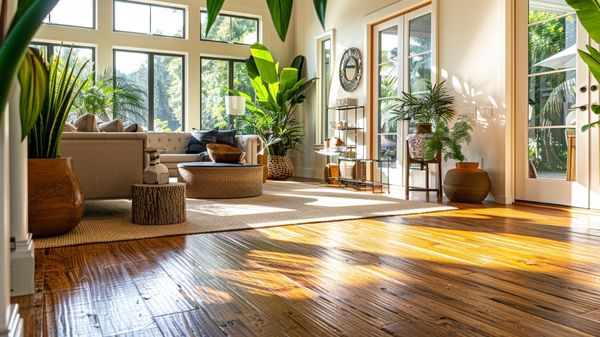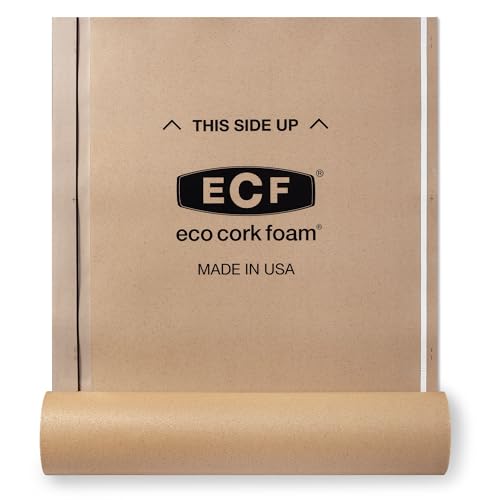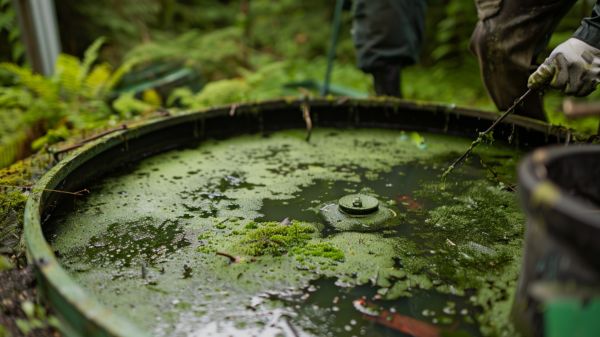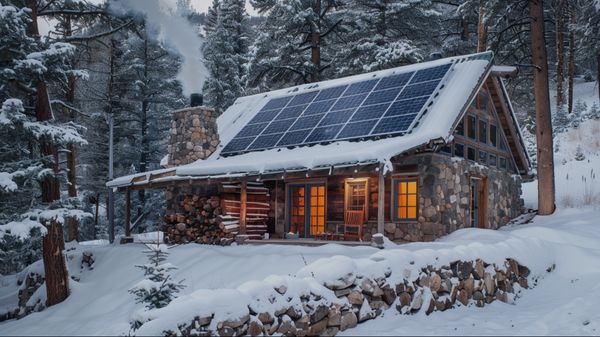When looking for sustainable flooring options for eco-friendly homes, prioritize hardwood and engineered wood, as they guarantee responsible sourcing and low VOC emissions. In addition, consider cork and bamboo for their renewable properties and durability.
Stone and tile options require minimal processing, thereby reducing their environmental footprint, while rubber and recycled flooring utilize repurposed materials to enhance sustainability and longevity. Moreover, softwood options emerge as cost-effective and easily installable solutions.
Each of these materials offers various benefits, contributing to energy efficiency, indoor air quality, and aesthetic appeal, which aligns with sustainable living practices and your design preferences in eco-conscious construction. More insights await.
Hardwood and Engineered Wood
When considering sustainable flooring options, hardwood and engineered wood stand out as practical choices that combine beauty with environmental responsibility.
Hardwood boasts several benefits, particularly when sourced sustainably, such as through FSC certification; this guarantees woods are harvested in ways that preserve ecosystems and maintain biodiversity.
Using locally sourced hardwood minimizes transportation-related carbon footprints, and low VOC emissions from finishes contribute to healthier indoor air quality, making it an attractive choice for environmentally conscious homeowners.
Additionally, eco-friendly hardwood flooring improves home aesthetics with its durable and luxurious surfaces, enhancing the overall look of any space. Moreover, sustainably sourced hardwood options typically contribute to a reduced carbon footprint, promoting responsible forest management.
On the other hand, engineered wood presents distinctive advantages worth noting. By utilizing a thin veneer of hardwood over a plywood or fiberboard core, engineered wood requires less traditional lumber, which considerably reduces the environmental impact associated with its production.
Its ability to handle moisture and natural expansion means it often lasts longer than solid hardwood, thereby reducing the need for frequent replacement. Additionally, the manufacturing process generates minimal waste, with byproducts being repurposed effectively, thereby promoting sustainability.
Together, these factors make both hardwood and engineered wood sensible options for those wanting to create an eco-friendly and aesthetically pleasing living space.
Alternative Eco-Friendly Materials
Exploring alternative eco-friendly materials for flooring opens up a world of sustainable options that don’t compromise on style or functionality. When considering natural fiber alternatives, bamboo stands out as a rapidly renewable resource—growing quickly and offering durability in various styles and colors. Additionally, bamboo grows at a remarkable rate of 1.5 inches per hour, making it an ideal choice for eco-conscious homeowners.
Cork, another excellent choice, is harvested from living cork oak trees, providing a resilient surface that adds comfort to any space. For those seeking carpeting, natural wool is an ideal biodegradable and stain-resistant option, while linoleum, made from linseed oil and other natural components, remains low in VOC emissions and available in numerous hues.
In addition to natural fibers, utilizing recycled materials enhances your eco-friendly approach. Recycled metal tiles introduce a modern flair while maintaining durability, whereas recycled glass tiles bring vibrant color to kitchens and bathrooms.
Rubber flooring, crafted from recycled tires, offers longevity without environmental impact. Opting for reclaimed wood not only promotes sustainability but also infuses character into your home.
Stone and Tile Flooring
Choosing sustainable flooring doesn’t stop at eco-friendly materials like bamboo and cork; stone and tile flooring presents a durable, attractive option that aligns with your commitment to the environment. Natural stone boasts remarkable stone properties, requiring minimal processing compared to synthetic alternatives, ensuring a low environmental impact.
The energy consumption associated with producing natural stone is a mere 3.3% of its production value, coupled with considerably lower CO2 emissions, particularly when utilizing local stone sources, which can reduce CO2 equivalents to just 0.16 kg per square meter. Furthermore, the sustainability of natural stone is amplified by its lower carbon footprint, making it an even more responsible choice for your home.
Moreover, the durability and longevity of natural stone mean it can last for generations with proper care, reducing waste and curtailing resource consumption. Its low maintenance requirements and non-toxic composition further promote healthier indoor environments, making it a wise choice for eco-friendly homes.
Additionally, the exceptional thermal mass of stone allows it to absorb and store heat, assisting in energy regulation within your living space. Considering these factors, natural stone flooring not only enhances your home’s aesthetic appeal but also provides considerable environmental benefits, establishing a solid foundation for your sustainable living commitment.
Rubber and Recycled Flooring
In recent years, rubber and recycled flooring has emerged as a top contender in the sustainable flooring market thanks to its eco-friendly credentials and versatility. By choosing this option, you’re not only enhancing your home’s aesthetic but also making a responsible choice for the environment.
Here are some notable advantages:
- Made from natural rubber or recycled tires
- Highly durable and resistant to wear and tear
- Non-toxic, improving indoor air quality
- Customizable to fit various interior styles
- Ideal for both indoor and outdoor applications
Rubber durability guarantees it withstands heavy usage, making it a reliable choice for homes and commercial spaces. Additionally, this flooring boasts a longevity of up to 50 years, outperforming many traditional materials like hardwood and vinyl.
Furthermore, the recycled tire benefits are considerable, as using waste tires for production markedly reduces landfill waste, while the eco-friendly manufacturing process conserves valuable resources.
The design versatility allows you to find the perfect look that aligns with your personal style, whether it’s a sleek modern vibe or a more traditional feel.
This sustainable flooring alternative not only adds value to your home but aligns with a growing commitment to environmental responsibility, reducing your ecological footprint while creating a comfortable living space.
Cork and Softwood Flooring
Harnessing the natural beauty and eco-friendliness of cork and softwood flooring, homeowners can create stunning, sustainable spaces that combine style with environmental responsibility.
Cork benefits extend beyond its appealing aesthetics, as it’s sustainably harvested from the bark of cork oak trees, allowing the tree to regenerate and remain healthy. Significantly, cork flooring is entirely biodegradable, recyclable, and naturally resistant to mold, offering both durability and comfort in high-traffic areas.
Its thermal insulation properties also lead to reduced energy costs, while its sound-muffling qualities enhance the tranquility of your home. Additionally, cork’s unique cellular structure provides exceptional durability, helping it last over 40 years with proper care.
On the other hand, softwood aesthetics provide a warm and rustic appearance that complements various interior designs, particularly in low-traffic areas like bedrooms or home offices.
The rapid growth cycle of softwood trees not only makes them a renewable resource but also contributes to reduced environmental impact through localized sourcing. Additionally, softwood’s affordability and ease of installation make it an attractive option for budget-conscious homeowners looking to achieve a stylish, eco-friendly space.
Together, cork and softwood flooring present compelling choices for those prioritizing sustainability in their home design.
Frequently Asked Questions
How Do I Maintain My Sustainable Flooring?
To maintain your sustainable flooring effectively, focus on regular cleaning tips such as utilizing microfiber mops and eco-friendly maintenance products like vinegar or natural soap.
Sweep or vacuum often to prevent debris buildup, especially in high-traffic areas, and damp mop gently to avoid excess water. Inspect for wear periodically, addressing any issues promptly to prolong the lifespan of your flooring. Prioritize eco-friendly solutions that minimize environmental impact while ensuring a thorough clean.
Is Sustainable Flooring More Expensive Than Traditional Options?
Sustainable flooring often seems like a financial Everest compared to traditional options, given the initial cost comparison, which typically ranges from $150 to $250 per square foot versus $125 to $200 for conventional materials.
However, considering long-term savings—such as reduced maintenance and increased durability—over time, sustainable materials can present a superior investment, potentially yielding higher ROI and resale value, and consequently offsetting the initial expenditure considerably.
Can I Install Sustainable Flooring Myself?
Yes, you can install sustainable flooring yourself, provided you’ve got the right DIY installation skills and flooring tools. Start by selecting the appropriate material, evaluating your existing floor, and gathering tools specific to that material.
Follow detailed instructional resources for installation techniques, like click-together methods or glue-down application. Remember to observe safety precautions, avoid moisture issues, and minimize waste during the process to guarantee a successful installation.
What Is the Lifespan of Eco-Friendly Flooring Materials?
When considering the lifespan comparison of eco-friendly flooring materials, you’ll find that options like hardwood can last decades, especially when maintained properly. In contrast, bamboo typically lasts 20 to 50 years due to its durability and quick regeneration.
Linoleum and natural flooring materials often exceed 40 years with minimal upkeep. Importantly, understanding these lifespans not only aids in your decision-making but also highlights the reduced environmental impact of choosing sustainable flooring options.
Are There Styles Available for Sustainable Flooring?
Yes, there are various styles available for sustainable flooring, including bamboo flooring, which provides numerous patterns and finishes, making it an adaptable choice for diverse interior designs.
Additionally, cork options feature unique natural patterns and textures, suitable for creating a mid-century modern aesthetic while promoting acoustic insulation. Both materials allow for customization, ensuring they can align with your specific design preferences while maintaining environmental considerations.
Conclusion
To sum up, selecting sustainable flooring options for your eco-friendly home not only enhances your living environment but also contributes positively to the global ecosystem. For example, consider integrating bamboo flooring, renowned for its rapid growth and renewability; this choice can greatly reduce your carbon footprint while providing a stylish aesthetic. By prioritizing such materials, you can create a harmonious balance between functionality and environmental responsibility, ultimately fostering a healthier home and planet for future generations.
| # | Preview | Product | Rating | Price | |
|---|---|---|---|---|---|
| 1 |

|
Nature Clean All Natural Wood Floor Cleaner for Mopping 36 Strips, Non-Toxic & Plastic-Free... |
$12.99 |
Buy on Amazon | |
| 2 |

|
JohnDow Industries PFM-500 Disposable Paper Floor Mats - Heavy Duty, Biodegradable, 500 Count Box | $61.92 $52.13 | Buy on Amazon |












